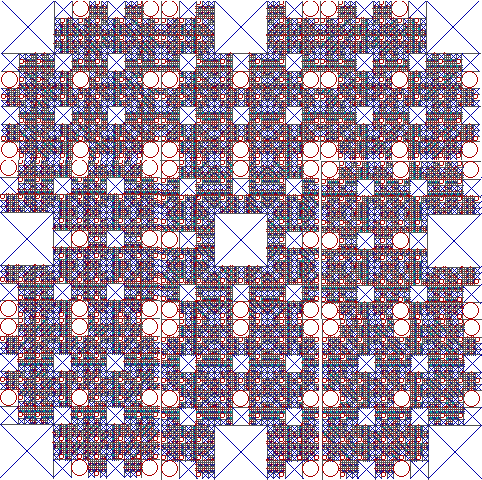Figure 1.

Figure 2.
Although our primary concern is with fractal images for formal theories, rather than for games, many of the techniques to be used can be made clear using a fractal image for the simple game of tic-tac-toe.
The first player in tic-tac-toe, conventionally labelled X, has a choice of one of nine squares in which to place his marker. The opposing player O then has a choice of one of the remaining eight squares. On X's next turn again he has a choice of seven squares, and so forth. There are thus a total of 9! possible series of moves (9 factorial: 9 x 8 x 7 x ... x 1), giving us 9! possible tic-tac-toe games. Some of these are wins for X, some for O, and some draws (wins for neither player). The fractal image shown in Figure 1, sections of which are progressively enlarged in Figure 2, offers an analytic presentation of all possible tic-tac-toe games.

Figure 2.
Suppose O chooses the upper right hand corner. This is represented by a move to the upper right square of the 9 squares in 2. That square is enlarged in Figure 2, showing the two moves by X and O in place but seven further options for X. Figure 2 continues by enlarging the squares chosen by particular players in the series we've chosen as an example: in this case the series continues with X to the center, O to the lower right, X to the center right, O to lower left, X to center bottom, O to center left, and X to center top. The result is a win for X, indicated in color by a blue shading.
In the largest view of the fractal, shown in Figure 1, patterns of yellow and blue can be used in the color version to indicate wins for O and X, respectively, though the yellow wins in particular are small enough--meaning deep enough in the game--so as to be practically invisible. Were the resolution of our illustration great enough, and our eyes sharp enought, we would be able to see all such wins embedded in the image. Winning strategies, as a matter of fact, could be thought of as spatial movements through the fractal toward those winning games.
Tic-tac-toe is convenient as an illustration because we have only two players, only three final outcomes of concern (a win for X, a win for O, or a draw), and because the game has a clear terminus after 9 plays. The principles of a game fractal could in principle be extended to checkers and even chess, though it's also clear that these would become explosively complex in short order1.
In what follows we begin by applying much the same fractal techniques to simple formal systems. In that application wffs or equivalence classes of wffs will replace moves or series of moves in the example of tic-tac-toe, colors for wins and draws will be replaced with colors coded to theorems, contradictions, and various contingencies, and fractal images used will be infinitely rather than merely finitely deep.